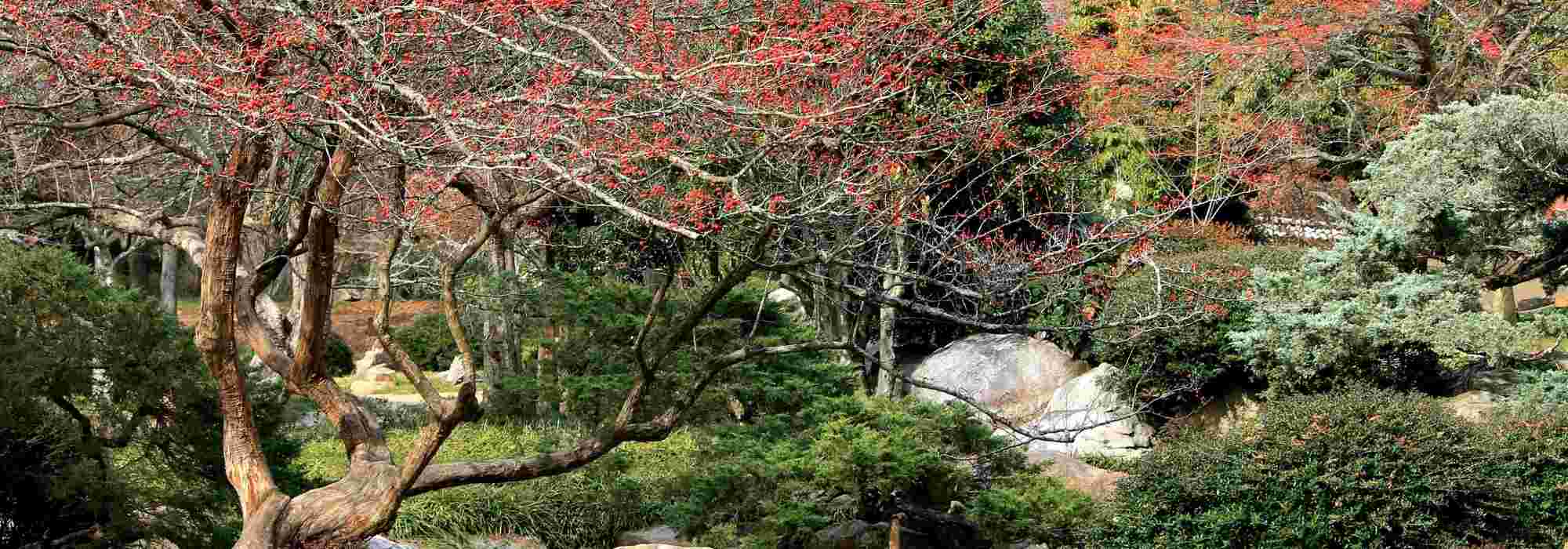
Designing a four-season garden
for a beautiful garden from spring to winter
Contents
One primarily enjoys their garden during the fine weather, in spring and summer, when the desire to step outside is at its peak and temperatures soar. But a garden should be beautiful all year round! Savoring late flowering in autumn extends the feeling of summer, while admiring trees donning their fiery hues gently ushers us into winter… and makes us want to stroll through the garden even in the so-called dreary season.
To ensure a garden remains attractive throughout the year, allowing us to appreciate these delightful seasonal changes in our northern hemisphere, it is essential to install evergreen plants for visual volume and structure, but also to choose plants that will enhance your spaces for a long time, and that will take turns from one season to the next. We must not only rely on flowering and foliage, but also on silhouettes, bark, and fruiting…
Discover how to create an attractive and flowering garden in every season, so it provides you with a symphony of colours and forms throughout the twelve months of the year! With a four-season garden, you will certainly enjoy your outdoor space even more!
→ Also read: Plants that are beautiful all year round
Think structure and volumes
The volumes provided by shrubs and trees in your garden form its backbone. They are essential for rhythmically structuring the spaces and ensuring your garden doesn’t resemble a dreary plain between November and March. Choosing your bushes and trees will depend on the persistence of their foliage and their silhouette. Your flowerbeds will be ornamental areas to design very skillfully.
The evergreens
To ensure a garden presents its best face even in the depths of winter, evergreen bushes and trees are a major asset, providing a lush visual and volumes in the garden. Evergreen foliage is often tough, glossy, and sometimes spiky. You will find, of course, the conifers, palms, and exotic plants (Agaves, Phormiums, Cordylines, Pittosporums, Eriobotrya…), as well as small trees like Magnolia grandiflora and Michelias, along with a whole array of shrubs that often bloom in mid-winter (Mahonia) or late winter (Viburnum tinus, Osmanthus), but also in spring or summer: the acid-loving shrubs like Rhododendrons, Azaleas, or Pieris, followed by Ceanothus, Arbutus unedo, Berberis, Cotoneasters, Teucriums, Choisyas, Abélia, etc.).
You will make even greater use of evergreens by designing a Japanese garden, a Winter Garden, or even an exotic garden, so keep that in mind! This can, of course, be limited to a small area of the garden that you design in this way to bring volumes and poetry, especially in winter.
The choice of evergreens is vast and will depend on your preferences for very diverse foliage. Some trees or shrubs will even be chosen solely for their extremely decorative foliage such as Eucalyptus, Aucuba, Pittosporums with small or large leaves, variegated holly, boxwood, Hellebores argutifolia, bamboo, etc.
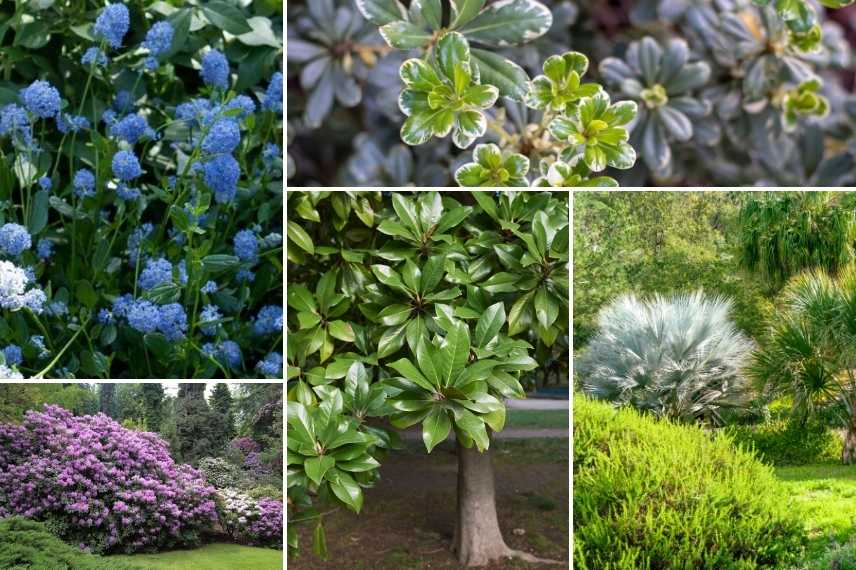
Varied silhouettes
The habits of shrubs rhythm and energise your garden by bringing different shapes that are pleasing to the eye. For a garden that looks beautiful all year round, it is particularly interesting to plant several conifers with very varied forms (spreading, rounded, columnar, etc.), as well as persistent exotic plants with a very attractive appearance in winter, to opt for deciduous trees or shrubs that will reveal their sculptural forms in winter and their remarkable bark like Lagerstroemia or birches in coppice, for example. Don’t hesitate to enhance your garden with a whole range of ornamental grasses that look magical in winter, with pyramid, weeping, or umbrella shapes to create very different focal points.
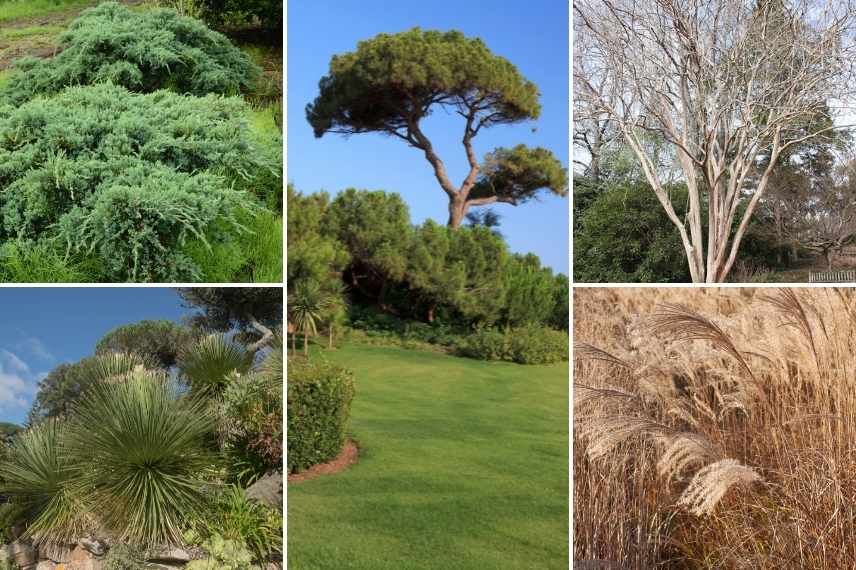
Designing flowerbeds
To ensure they look beautiful all year round, you will need to create a clever mix of plants from the four seasons so that the flowerbed is not inert in autumn or winter. Of course, this implies some “gaps” at certain times, often balanced by the presence of evergreen foliage and groundcovers, and largely compensated by the constant appeal of colours and shapes in the flowerbed.
Designing flowerbeds is certainly the most delicate aspect as it involves harmonising your plantings as best as possible: you will do this across a chosen colour range in shades or contrasts depending on the desired style and the location in the garden (house entrance, romantic mixed border, wild naturalistic bed, wooded grove, etc.), knowing that you will pay particular attention to the edges of the house and the views from your interior. Of course, you will consider the pH of your soil, which may lead you in some cases to create flowerbeds with heather soil. These will mainly bloom in spring, so you will add summer blooms like Lilies, and autumn blooms with Liriope, for example.
Finally, some plants will allow you to create rockeries, perennial and beautiful all winter with the inclusion of low conifers and persistent plants like heathers, or depending on your region, exotic scenes, unchanging regardless of the season!
Read also
The most beautiful barksMaking the most of the seasons
To keep your garden vibrant throughout the year, the key is to make a wise choice of plants that will dress it up in every season, spreading and alternating the flowering and ornamental interests offered by both evergreen and deciduous foliage. While it is impossible to list all the perennials, bushes, and trees with seasonal interest here, which will primarily be chosen based on your garden’s style, soil, exposure, and your colour preferences, I suggest exploring the main strengths of a garden by season.
Spring
Season of renewal, the new green foliage of deciduous trees and shrubs offers ultra-bright and fresh hues, and many shrubs adorn themselves with absolutely charming blooms on bare wood, often in white, yellow, or pink shades. We can count on a large number of plants providing a burst of vibrant colours in the garden from March to May. It is especially important to mix early and late bloomers during this prolific season in the garden.
- Regarding early spring shrubs, one cannot do without Japanese quinces, Forsythias, Magnolias, Wisteria, and Kerria japonica,
- In mid to late spring, depending on the climate and exposure: Lilacs, Ceanothus, Rhododendrons, Azaleas, Kalmias, Laburnums, Clematis, Cistus, Viburnum, Deutzia, Sambucus nigra… will bring incredible charm to your garden
- The importance of bulbs: the days are getting longer, but the heat is not yet strong enough for many plants. It is often a wide range of bulbous plants (tulips, daffodils, muscari, Camassias, Ipheons, Alliums, etc.) that will colour your garden in the early months of the year, so indulge freely… alongside some spring-flowering shrubs.
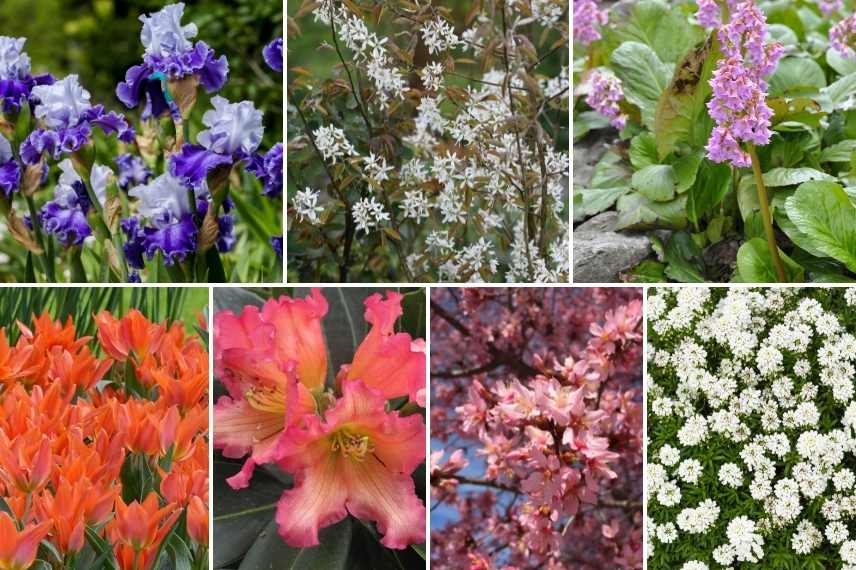
Iris, Amelanchier canadensis, Bergenias, Botanical tulips ‘Greigi Toronto’, Rhododendron ‘Unique Marmelade’, Prunus, Iberis sempervirens
→ Read: How to have an attractive and flowering garden at the beginning of spring?
Summer
A much-anticipated season, it provides plants with the longest days and warmth conducive to the flourishing of many admirable plants. In summer, all plants, trees, shrubs, perennials, and grasses are now lush, and we enjoy abundant foliage and flowers. During this major season, when we will often enjoy the garden for obvious climatic reasons, it is essential to ensure staggered flowering, as they often prove less generous than in spring, with temperatures putting them to the test. Also, consider installing plants with long-lasting blooms, up to frost, especially in small gardens where you are limited in the number of plants.
- Our selection of long-lasting blooms: Gauras, Sages, Alstroemerias, Verbena from Buenos Aires, Valerian, Crocosmias, Liatris, Hardy geraniums, Hydrangeas, Fuchsias, Lavateras, Lavenders, Phlox, Dahlias, and for annuals, the irreplaceable Impatiens
- Some remarkable summer shrubs and climbers: Star jasmine, Chitalpa, Albizia julibrissin, Abelia, Vitex agnus, Lagerstroemia, Buddleia, Oleander, Trumpet vine…
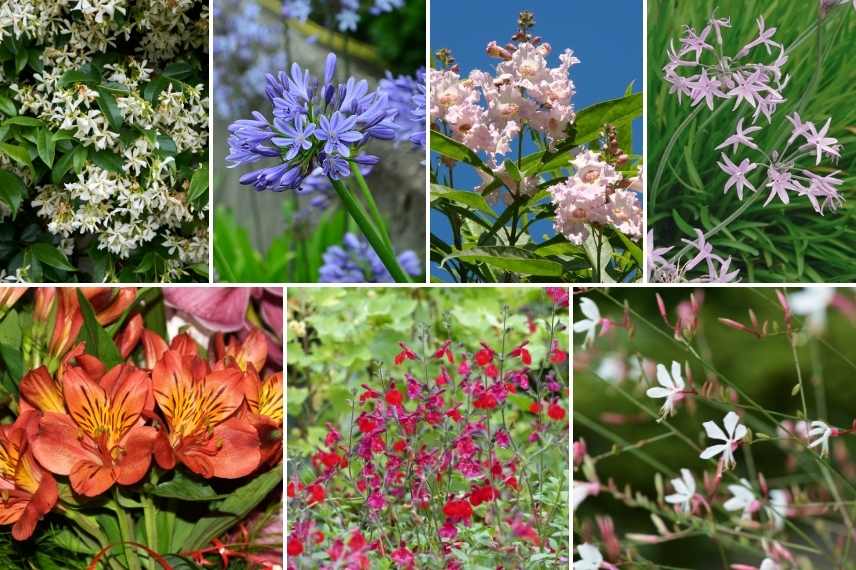
Trachelospermum jasminoides, Agapanthus, Chitalpa, Tulbaghias, Alstroemeria ‘Indian Summer’, the lightness of Sages and Gauras
→ Discover also 7 plants in bloom all summer and 7 sun perennials with long flowering
Autumn
This is one of the seasons when you should particularly think about the garden! With temperatures still mild and rains arriving, it is often the time conducive to the flourishing of many late-summer perennials and bulbous plants: focus on Dahlias, Japanese anemones, Sedums, and Asters, and on the grasses at the peak of their beauty. We still often go to the garden, and it is useful to play with pots that can be moved to sunnier areas to prolong our enjoyment. Autumn is also obviously the transition season to winter, which sees the foliage beautifully redden. We recommend planting some shrubs whose foliage turns beautifully in autumn for a dazzling display, and depending on your available space, one or more autumn-flowering shrubs. This is truly a season to plan ahead (a bit like spring) to see the autumn bulbs thrive.
- Some plants with reddening foliage: Parrotia persica, Cercidiphyllum, many Viburnums (including Viburnum opulus, Viburnum x burkwoodii), Liquidambars, Stewartia pseudocamellia, Maples and Japanese maples, Japanese spindle trees, Parthenocissus (virgin vine)…
- late-flowering shrubs: Clerodendron, Heptacodium, some Lagerstroemias and Hydrangeas
- a selection of long-lasting late perennials: Japanese anemones, Asters, Sedums, Salvia Elegans, Persicarias, Eupatoriums, Liriopes, Dahlias, Schizostylis, Ajania pacifica, Chrysanthemums and Euryops…
- spectacular grasses: Miscanthus, Calamagrostis, Shizachyrium, Muhlenbergia capillaris…
- magical autumn bulbs like Nerines, Cyclamen coum, colchicums, Amaryllis belladonna,
But also the magnificent Camellias sasanqua, Pyracantha that then offer their colourful berries, and in large gardens, Quercus palustris and coccinea, etc.
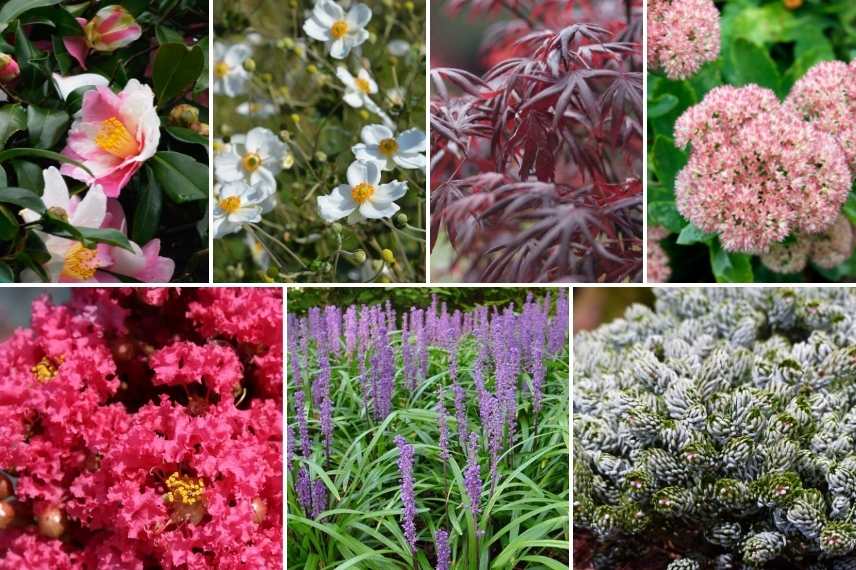
Autumn camellia, Japanese anemones, Acer palmatum ‘Trompenburg’, Sedums, Lagerstroemia indica ‘Grand Cru’, and Liriope ‘Royal Purple’
→ Discover also 8 clematis with autumn flowering and Keep smiling: late blooms chase away the end-of-summer blues!
Winter
Let’s not kid ourselves, winter is not exactly the season when the garden is overflowing… but by incorporating certain barks or woods and ornamental fruits, along with astonishing blooms that are often wonderfully fragrant, it is a time of year when we can play with more poetic notes, not devoid of interest. Moreover, by keeping inflorescences on stems without pruning, such as Sedums, hydrangeas, and many grasses, you bring an incomparable magic on frosty days!
The trees and evergreens perfectly play their role as the garden’s framework, literally dressing the horizon, the bare woods offer often striking colours, the upright and creeping conifers showcase their superb foliage, and parchment-coloured grasses illuminate the garden… All this little world can even come together in stunning masses creating enchanting Winter Gardens! Not to mention the particularly fragrant plants of winter…
It is therefore necessary to incorporate these different types of plants here and there in the garden:
- essential trees: Birches and certain maples (Acer Davidii, Acer griseum…) to enjoy the most beautiful barks, blue Cupressus or Abies, majestic Magnolias grandiflora, hazels and twisted willows for their incredible silhouette,
- winter star shrubs: Hamamelis with its frizzy flowers, Viburnum bodnantense and Daphnes with their intense fragrance, Winter jasmine, Mahonia and Edgeworthia shining, Lonicera fragrantissima, decorative wood Cornus like the sublime Cornus alba ‘Kesselringii’, Chimonanthus praecox, Camellias, Hazels and willows with pendulous catkins, Abeliophyllum distichum ‘Roseum’, not to mention many heathers (Ericas)…
- graceful climbers: Clematis cirrhosa and Clematis armandii
- Deliciously fragrant plants: Viburnum bodnantense, Sarcococcas, Lonicera fragrantissima, Daphnes…
- dreamy fruits: Ivies, Holly, Firethorn, Skimmias japonicas, Cotoneaster…
- evergreen perennials and groundcovers: Hellebores, Euphorbias, Helichrysum, Iris foetidissima, Cotoneaster
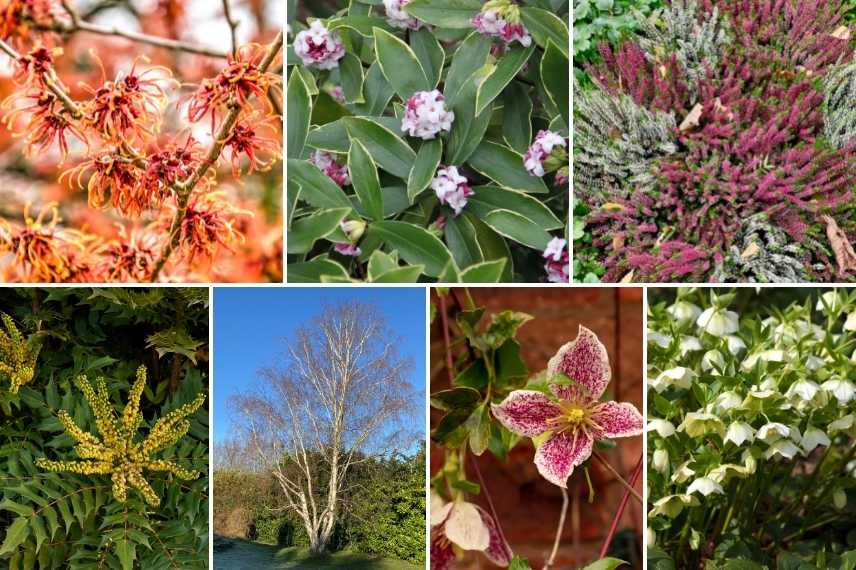 Hamamelis, Daphne, Heathers, Mahonia, Birch, Wax clematis, Hellebores…
Hamamelis, Daphne, Heathers, Mahonia, Birch, Wax clematis, Hellebores…
→ I give you 3 ideas for beautiful winter beds in this article to inspire you!
Some tips to make the right plant choices
Planting perennials and repeat flowering shrubs
These are plants that bloom again a few weeks later, once pruned (sometimes they manage to do it themselves), generally at the end of summer. You benefit from a renewal of your plants and a dazzling array of colours: Besides repeat flowering roses, Nepetas, hardy geraniums, and Alchemillas are well-known examples, just like Choisya, Wisteria, rosemary, repeat flowering irises, Encore azaleas, etc. Also consider Osmanthus fragrans ‘Aurantiacus’, a superb fragrant bush that blooms until October in successive waves!
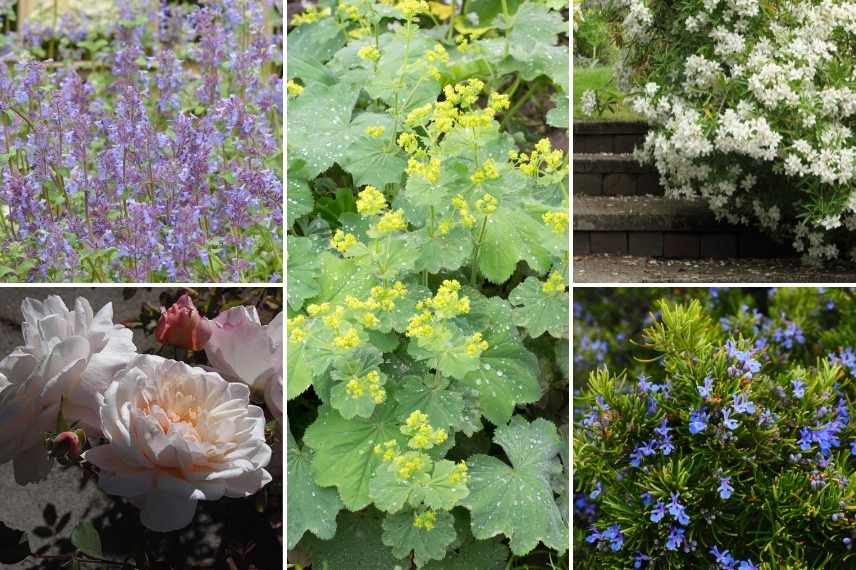 Among the plants that extend the season: Nepeta ‘Six Hills Giant’, Old rose ‘Gruss An Aachen’, Alchemilla mollis, Choisya ternata, and rosemary are perfect candidates for repeat flowering
Among the plants that extend the season: Nepeta ‘Six Hills Giant’, Old rose ‘Gruss An Aachen’, Alchemilla mollis, Choisya ternata, and rosemary are perfect candidates for repeat flowering
Focus on “3 in 1” plants
Preferably, especially in small gardens where space is limited, choose species that combine several ornamental features. They provide graceful flowering, remarkable or changing foliage in autumn, and bark, silhouette, or winter fruiting that extends their interest over three or four seasons.
⇒ Our selection: Skimmias japonica, Arbutus unedo, Amelanchier, Nandina domestica, Cotoneaster, Aucuba japonica, Pomegranate, Ornamental apple trees, Hypericum inodorum, Maples including Acer griseum, Birches and Hazels, Persimmon, Clerodendron, Stewartia pseudocamellia, Mahonia, Decorative wood Cornus, Poncirus trifoliata…
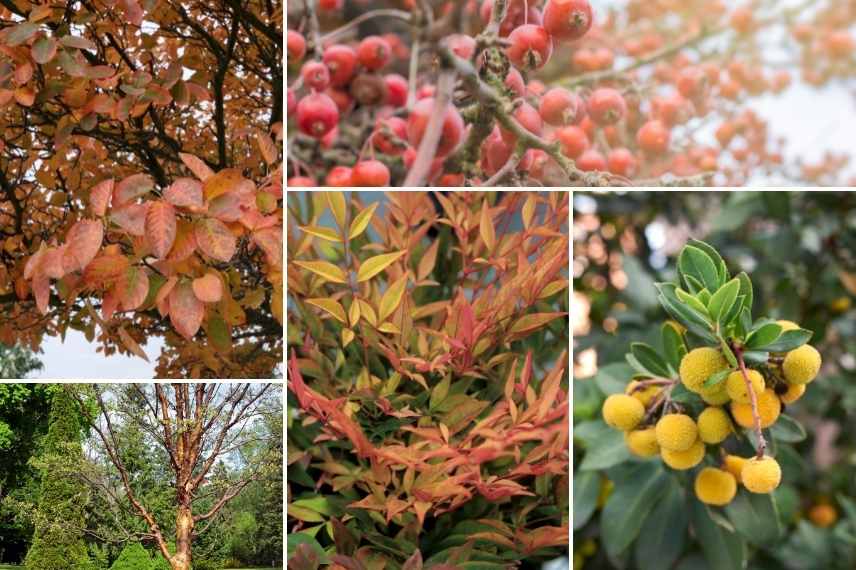 Amelanchier with autumn-colouring foliage (it also has superb flowering and fruiting), bark of Acer griseum (besides its beautiful foliage, especially in autumn), Ornamental Malus (with lovely spring flowers and small fruits on the tree all winter), Nandina combining emerging and superb autumn foliage as well as winter berries, and Strawberry tree with sublime flowers, fruits, habit, and bark…
Amelanchier with autumn-colouring foliage (it also has superb flowering and fruiting), bark of Acer griseum (besides its beautiful foliage, especially in autumn), Ornamental Malus (with lovely spring flowers and small fruits on the tree all winter), Nandina combining emerging and superb autumn foliage as well as winter berries, and Strawberry tree with sublime flowers, fruits, habit, and bark…
Adopt the longest flowering plants
Many plants bloom for a long time, which is great for our four seasons garden, as they often display their finery over two seasons, spring and summer, and even autumn! Leptospermum, Grevillea, Abelias, Lagerstroemias, and Potentillas among the shrubs; Gauras, Sages, Alstroemerias, Tulbaghias, Japanese Anemones, Persicarias, and Daylilies among the perennials. Remember that exposure is crucial for the duration of flowering: for example, Japanese Anemones will be much more vigorous in a truly shaded position, lasting several weeks longer than if planted too much in the sun…
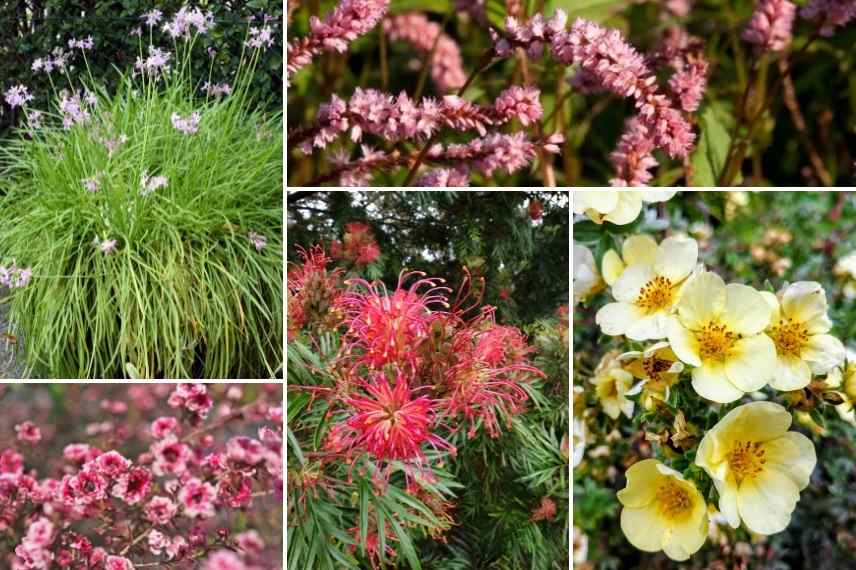 Tulbaghias, Persicaria (here ‘Pink Elephant’), Leptospermum scoparium, Grevillea, and Potentilla ensure very long flowering periods
Tulbaghias, Persicaria (here ‘Pink Elephant’), Leptospermum scoparium, Grevillea, and Potentilla ensure very long flowering periods
Combine the same type of plant with staggered flowering times
Many perennials or bushes bloom more or less late depending on the varieties. To ensure a bed lasts a long time in the same tones or spirit, check the flowering periods, and group, for example, peonies or irises that bloom over 3 different months for a beautiful floral effect, or Stoechas lavenders and English lavenders that will succeed each other brilliantly!
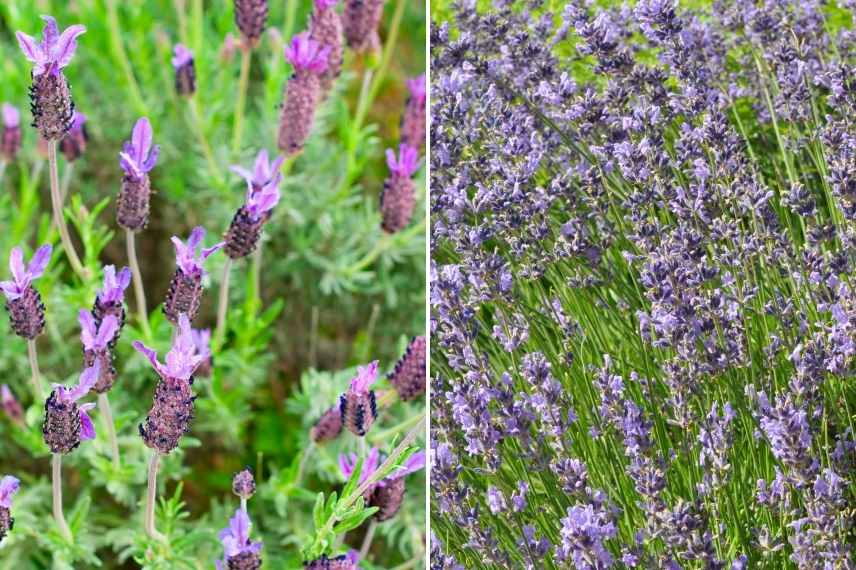 English lavenders take over once the butterfly lavenders have finished blooming
English lavenders take over once the butterfly lavenders have finished blooming
Plant evergreen groundcovers
Groundcovers provide significant plant cover during the coldest months, greening the bases of trees and the gaps in beds, especially when they are evergreen or semi-evergreen. They create a real green effect, especially interesting when mixing foliage colours, such as the golden of Heucherella ‘Eye Spy’, the variegated of Euonymous fortunei ‘Sunspot’, or the blue of Carex ‘Blue Zinger’!
- Subscribe!
- Contents
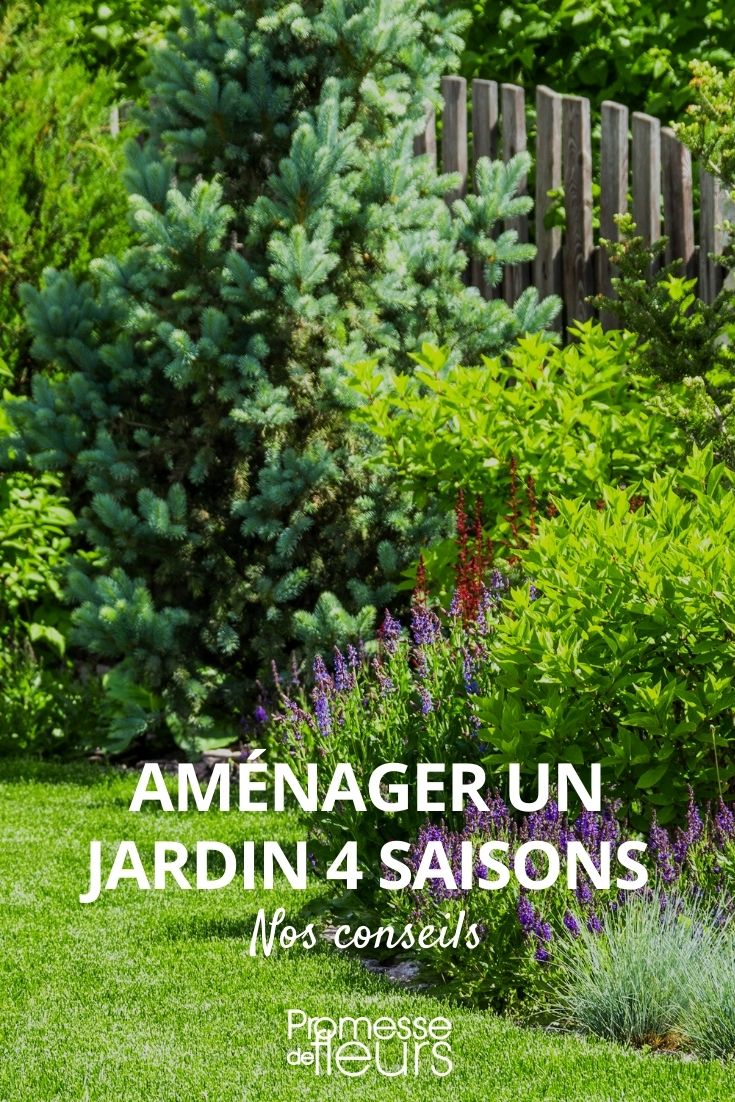































Comments